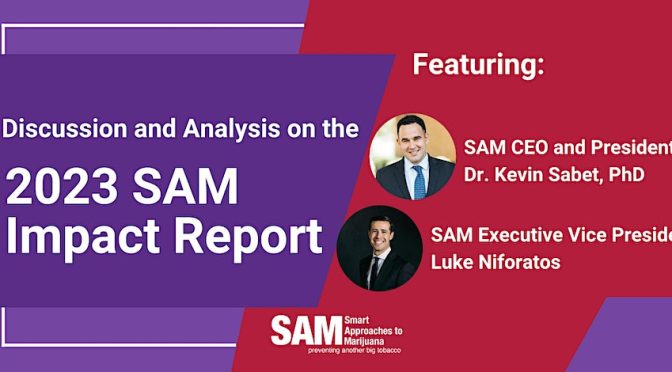Smart Approaches to Marijuana (SAM) recently released a “Lessons Learned” report showing what we’ve known all along: there’s no good way to legalize marijuana. The time has come for states to repeal this policy and put Pandora’s evils back into the box. Data continues to show the damaging effects of marijuana legalization.
SAM’s 2023-2024 report presents a different reality than the narrative advanced by BIG POT, which considers only money. SAM’s President and Executive Vice President will explain the report in a webinar on June 16th. We encourage you to attend to hear Kevin Sabet and Luke Niforatos.
Legalization has had a devastating impact on children and young adults, not only because of the poisonings described previously, but several other problems.
State-regulated pot shops have increased the potency of marijuana to make their products more competitive (and more addicting). Today’s weed is considerably more dangerous than in the past, due to the substantial increase in percentages tetrahydrocannabinol (THC). The average potency has increased nearly five times since 1995. In 1995, THC levels were 3.75%, but by 2018, the average jumped to 15.80%.
Dabs and vapes — which are popular with teens — can be 50 percent to more than 90 percent THC. A high percentage of teens are using these high potency products, rather than the traditional flower smoked in the past.
Usage rates go way up
Next, combined with this devastating realization, is the dramatic increase in marijuana users over approximately the same timeframe. In 1992, it was estimated that about 17.5 million people used marijuana in the United States. By 2021, this total surged to approximately 52.5 million users, a 300% increase in a little over a generation. And, remember, these users are using a more potent drug than their 90s counterparts. It’s happening at a time when the nation faces an unprecedented mental health crisis
Young adults between 19 and 30 have shown the greatest surge in usage. Statistics show that, in 2021, 29% of this age group reported using weed over the last month. This was an increase from 17% a decade earlier in 2011. People reporting daily use of marijuana also increased, jumping from 8% in 2011 to 11% in 2021.
At a time when studies show that cannabis is linked to a slew of mental health problems, the perception of harm should be rising. Instead, it’s going down with our youth. As of 2021, less than 13% of high school seniors believe that occasional use of marijuana is harmful, a drop from 40.6% of high school seniors in 1991. Comparatively, only 21.6% of high school seniors believe that regular use of marijuana is harmful, a decline from 1991, when 78.6% of 12th graders believed doing so was dangerous.
CUD and Vaping Diseases rise, too
Recent studies have shown another disturbing revelation. Among current marijuana users, 30% of them have a cannabis use disorder (CUD). Furthermore, the likelihood of suffering from CUD increases nearly seven times when people start using the drug before they are 18. The push to legalize weed nationwide as well compounded the problem. It has led to a 25% increase in marijuana use disorder among pre-teens and teenagers, specifically those from 12-17 years old.
Furthermore, unlike their predecessors, today’s marijuana users also get high through vaping. This practice has already been linked to numerous ill consequences, including EVALI lung disease. Statistics show that between 2017 and 2021, the percentage of high school seniors who have vaped using marijuana nearly doubled, jumping from 9.5% to 18.3%.
Big Pot also causes issues for young people on the roadways. In 2021, 10.67 million people admitted to operating a vehicle while under the influence of marijuana. Approximately 1.36 million of them were between the ages of 16 and 20. Additionally, there were 2.41 times more minors on the road under the influence of marijuana than were under the influence of alcohol. We see the effects of this increase in the number of crashes caused by teens using THC and driving their friends.
Think about our youth and public safety
The country’s youth is highly vulnerable to the harmful consequences of legalization, despite many of the public’s claims to the contrary. Our nation’s children repeatedly suffer negative health issues stemming from the nationwide push over the last decade.
Cannabis companies get away with advertising on billboards and in social media — in ways not allowed for tobacco.
Warning labels are missing, but they should include mental illness, respiratory problems, hallucinations, heart attacks, and acts of extreme violence.
Despite these issues, Big Pot continues to put profit before principle. A company in Florida has already donated $25 million to the legalization ballot in Florida next year, hoping to make even more money.

